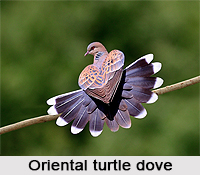 Oriental Turtle Dove or Rufous Turtle Dove is an Indian bird that bears a scientific name "Streptopelia orientalis" is a member of the bird family of Columbidae, doves and pigeons.
Oriental Turtle Dove or Rufous Turtle Dove is an Indian bird that bears a scientific name "Streptopelia orientalis" is a member of the bird family of Columbidae, doves and pigeons.
Names of Oriental Turtle Dove
Oriental Turtle Dove has both the names Oriental Turtle Dove and Rufous Turtle Dove have been used for this species. It has been suggested that the name Rufous Turtle Dove should be used for the western form meena, and Oriental Turtle Dove for the nominate orientalis.
Races of Oriental Turtle Dove
Oriental Turtle Dove has two distinct migratory northern races, S. O. orientalis in the central Siberian taiga, and S. O. meena in open woodland of central Asia. There are also two non-migratory southern races. Two other races have been described from East Asian islands.
Structure of Oriental Turtle Dove
Oriental Turtle Dove is a small species that is very similar in plumage to its European counterpart, the Turtle Dove. It is a little larger than that species, particularly in the case of orientalis, about the same size as a collared dove. It shares the black and white striped patch on the side of its neck, but the breast is less pink, and the orange-brown wing feathers of the Turtle Dove are replaced with a browner hue, and darker centres. The tail is wedge shaped, like the Turtle Dove. The flight is more relaxed and direct than that of its relative.
Tail Patterns of Oriental Turtle Dove
The differences in the tail patterns of Oriental Turtle Dove are in the forms S. O. Orientalis and S. O. Meena have been widely reported. Orientalis is described as having a grey tip to the tail and more black in the outer web of the outer Tail-Feathers, while the Meena has a white tip to its tail like the Turtle Dove and less black in the outer web of the outer Tail-Feathers. However, these are not consistent differences: both forms can have white or grey tail-bands, and Orientalis can have little black in the outer webs of the outer tail-feathers.
Population of Oriental Turtle Dove
The population of Oriental Turtle Dove is suspected to be stable in the absence of evidence for any declines or substantial threats.











